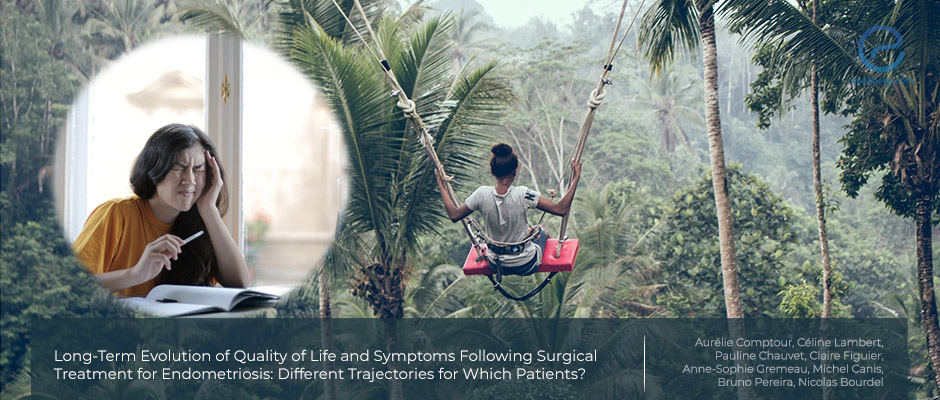Pain and Quality of Life Following Surgical Treatment for Endometriosis
Sep 25, 2020
Although laparoscopic surgery is effective for most endometriosis patients, some patients appear to be more eligible for surgery than others and experience greater benefits
Key Points
Highlight:
- A diverse outcome in the long-term symptoms and quality of life experienced by patients having undergone the first laparoscopic surgery for endometriosis.
Importance
- Completed information gathered from epidemiological methods is useful in the selection of patients eligible for surgery
What is done here?
- 962 patients who underwent laparoscopic treatment for endometriosis were considered in this multicenter cohort study.
- Prior to surgery and at 6,12,18,24 and 36 months after surgery, questionnaires were used to evaluate the quality of life and intensity of pain.
- Using a group-based trajectory modeling, individuals were gathered into meaningful subgroups with statistically similar trajectories.
- By multiple correspondence analysis and a mixed unsupervised classification, clusters of patients sharing similar characteristics are compared to the different trajectory groups.
Key results:
- The study revealed clear distinctive trajectories of pain and the quality of life. The group-based trajectory model approach for each pelvic symptom was as follows:
- No or minimum pain before and after surgery over a long-term period (35% of all patients).
- Patients with improvement, preoperative pain showed long-term improvement after surgery (23% of all patients).
- Patients with severe preoperative pain, that may be reduced but still persistent for long-term after surgery (42% of all patients).
- For "Physical" and "Mental Component" trajectories, the groups were:
- Patients with the highest quality of life remained stable before and after surgery (53% of all patients).
- Patients with altered preoperative quality of life showed improvement after surgery and remained stable for a period of years (36% of all patients).
- Patients with severe altered or poor preoperative quality of life are only slightly improved and remained stable over a period of years (11% of all patients).
- Multiple correspondence analysis revealed four clusters of patients before surgery:
- Patients in Clusters 1 and 2 were older, presented with infertility and pregnancy desire. They reported low-intensity symptoms and a good quality of life.
- Patients in Cluster 3 and Cluster 4 were younger, had a pregnancy desire, less infertility; but reported the most severe symptoms, a greater use of antalgics, and an altered QoL.
- A comparison between clusters and trajectories revealed similar tendencies: More than 50% of patients from Clusters 1 and 2 were in the upper, stable trajectory. By contrast, more than 50% of patients from Cluster 3 and 4 were in the trajectory with improvement.
Limitation of the study
- The limitation of the study relates to missing data.
Lay Summary
Currently, laparoscopy is the preferred approach as a surgical treatment of endometriosis. Many studies have shown the effectiveness of laparoscopic surgery to reduce the painful symptoms and improve the quality of life for patients with endometriosis in the short term and long-term period. It was reported that surgical treatment globally reduced the symptom of pain and improve the quality of life as early as six months after surgery and even maintained in the long-term period.
The study by Comptour et al. From France, aimed to analyze the individual long-term approach following laparoscopic surgical treatment for endometriosis and to identify them based on the patient types on 962 patients. Identifying different groups of patients was based on the evolution of pelvic pain intensity for dyspareunia, dysmenorrhea, and chronic pelvic pain, and Physical and mental Component Summary scores using a questionnaire. This interesting article is recently published in the "Journal of Clinical Medicine".
The group-based trajectory modeling method revealed three categories of patients for pelvic pain and the quality of life. However, the findings showed heterogeneity of long-term pain symptoms and quality of life experienced by patients who had first surgery for endometriosis. The benefits of surgery are mostly experienced by patients in trajectory 2 of pelvic pain and quality of life, who after surgery reported the greatest improvement in pain. Furthermore, the Multiple Correspondence Analysis revealed 4 clusters of patients before surgery. The analysis further compared the clusters and trajectories revealing similar tendencies. A majority of patients belonging to Cluster 1 and 2 who have less pain, or no pain before surgery experienced no longer pain after surgery. However, among the patients in Cluster 3 and Cluster 4 who experience severe dysmenorrhea prior to surgery experience important relief from surgery. But to some who reported having chronic pelvic pain and dyspareunia may continue to experience intense/moderate pelvic pain after surgery.
A clear trajectory for the progression of symptoms and quality of life after surgery corresponds to clusters of patients. The information gathered will be valuable to complete the information from epidemiological methods that are currently used in the selection of patients eligible for surgery.
"Certain patient profiles are more likely to undergo surgery than others, however, it remains difficult to accurately predict which patients will benefit from improvement in pain and quality of life. We have revealed, for the first time, clear trajectories for the progression of symptoms and quality of life after surgery that correspond to clusters of patients. This information may serve to complete that obtained from epidemiological methods currently used in selecting patients eligible for surgery", the authors concluded.
Research Source: https://pubmed.ncbi.nlm.nih.gov/32752110/
Global-based trajectory Physical Component Quality of Life Multiple Corresponce Analysis pelvic pain (Cpp) dysmennorhea Dyspareunia

